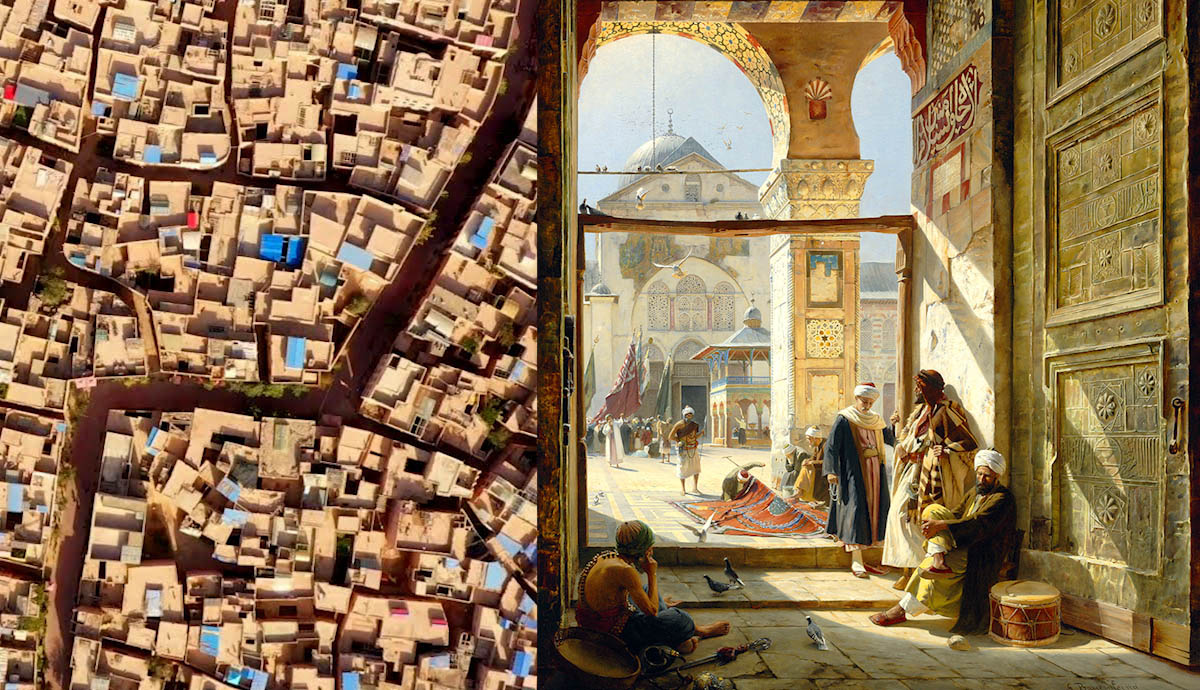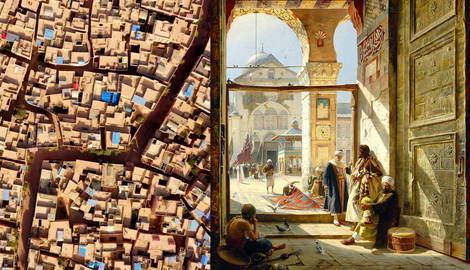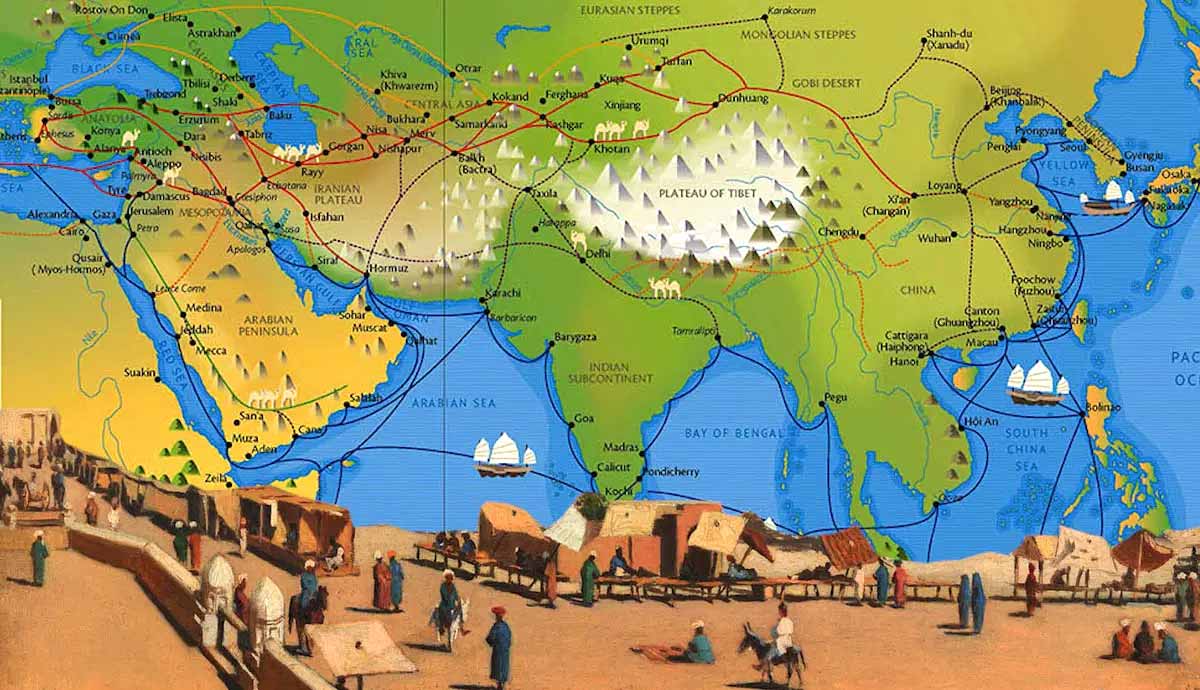
The Silk Road, which crossed Asia and Europe, was a great channel for cultural and mercantile exchange between Eastern and Western civilizations. A large number of cities emerged along the route and became melting pots where different civilizations met.
What Was the Silk Road?

This legendary ancient trade route linked Asia and Europe across the vast landmass of Central Asia. Travelers and traders came from areas such as present-day China, Iran, Turkey, Greece, and Italy, all of which were part of the Silk Road. The roots of the Silk Road go back to the Western Han Dynasty (202 BCE – 9 CE). However, it was during the Tang Dynasty (618 – 907 CE) that the Silk Road saw the greatest international activity.
From archaeological finds and surviving texts, especially those discovered in the last two decades, there is evidence of an almost incessant flow of goods and ideas across Eurasia. Porcelain, silk, paper, and gunpowder traveled from East to West, while chariots, wool, glass, and wine came into China. Even ostriches and rhinos found their way to the Chinese imperial court in Chang’an. The linking of diverse foreign lands made the Silk Road a melting pot of cultural fusion, and this was no more evident than in the cities that developed along the ancient trade routes.
1. Chang’an (Near Xi’an)

The ancient city of Chang’an, near present-day Xi’an in Shaanxi Province, is regarded as the eastern starting point of the Silk Road. With more than a million inhabitants at the height of its prosperity, Chang’an was one of the largest cities in the world. As the political, economic, and cultural center of ancient China, this was a popular destination for foreigners, most of whom came to Chang’an via the Silk Road.
During the Tang Dynasty, Chang’an had two main markets — the West and the East. The eastern market was mainly reserved for members of the imperial family and aristocrats, while the western market was open to the common people and was best known for its trade in foreign goods. The western market developed into a flourishing trading center, where goods from all over the world were available — jewelry, silk, tea, exotic herbs, and rare medicines. Cultural and artistic influences also reached Chang’an via trade connections to other countries along the Silk Road, influencing local tastes in everything from food to fashion.
2. Dunhuang

For more than a thousand years, Dunhuang was an important commercial, cultural, and military center on the Silk Road. Dunhuang is located at the westernmost end of the Hexi Corridor in China, where the three provinces of Gansu, Qinghai, and Xinjiang meet. It is a small oasis surrounded by the Gobi Desert. Dunhuang occupied a strategic position, connecting the Central Plains of China to the east, with Xinjiang and Central Asia to the west.
In the second year of the reign of Emperor Wu of the Han Dynasty (121 BCE), the Xiongnu army was defeated by the Han army. Dunhuang became a hub of imperial military, commercial, cultural, political, and transportation activities on the road from the Central Plains to the Western Regions. Under the conditions of slow travel, communication difficulties, and a harsh natural environment, Dunhuang became a refuge for humans and animals and a transit point for the exchange of commodities during the long journey.
Dunhuang became the first place where Buddhism was introduced into the East. Zhu Fahu and his disciples translated Buddhist scriptures and disseminated doctrines in Dunhuang during the Jin Dynasty (266 – 420 CE). Soon afterward, a monk named Lezun came to Dunhuang and excavated the first of the magnificent Mogao Grottoes. The earliest dated printed book, a Tang-dynasty Buddhist manuscript known as the Diamond Sutra, was found in Dunhuang in 1907.
3. Kashgar

Kashgar, the westernmost city in China, was the focal point of the Silk Road for centuries. Geographically, Kashgar is the “Wild West” of China, in the far west, not far from the borders with Kyrgyzstan, Kazakhstan, and Pakistan. The city thrived as the interface between Central Asia and China, being the assembly point for caravans heading westwards towards Samarkand or eastwards across the fearsome Taklamakan Desert.
According to legend, the Chinese Emperor Wu of the Han learned that the people here owned special horses that had come down from heaven and sweated blood. He wanted these horses for his own army and sent an emissary. This mission opened the way for China to the western areas beyond the desert. Since then, the Chinese have claimed rule over the Kashgar oasis and its people. However, they never had complete control of the area, and over the past two millennia, they have ruled over Kashgar for less than 500 years, with many interruptions. In the ancient oasis city, the Uyghur minority still makes up the majority of the population.
In the last century, Kashgar became the center of intrigues and conspiracies, the bone of contention between three great world empires: England, Russia, and China. Together they played the “Great Game,” as the struggle for rule over Central Asia and its riches was called. Kashgar became a melting pot of diplomats and spies, officers and archaeologists, explorers and adventurers from all over the world.
4. Samarkand

The source of China’s wealth during the Tang dynasty, namely the transcontinental trade in luxury goods, was largely organized by a people who are now almost forgotten: the Sogdians. By the end of the 1st millennium BCE, the Sogdians had a highly developed civilization with large fortified cities, such as Samarkand (known to the Greeks as Marakanda). Located on a plateau on the westernmost tip of the Alai Mountains, Samarkand benefited greatly from its location at the heart of the Silk Road. Founded around 2,750 years ago, the city was conquered by several famous and powerful rulers over its long history. These include Alexander the Great, Genghis Khan, and Timur (also known as Tamerlane).
From the 6th to the 8th centuries, the Sogdians ruled the largest trading empire in Asia. A prerequisite for their success in the most varied of Asian countries was, in addition to extensive language training, an open-mindedness in religious matters. Although many Sogdian communities practiced forms of Zoroastrianism, they were open to other religions, such as Buddhism, Christianity, and Manichaeism. Another pillar of their success was their flexibility in adapting their business to new political circumstances.
5. Balkh

The ancient city of Balkh was known as the “Mother of Cities,” but was completely destroyed by Genghis Khan’s army in the 1220s. Afghanistan was once the political, economic, social, and religious center of Asia. The Silk Road once attracted countless nomads, warriors, settlers, adventurers, and missionaries throughout the region, all of whom left their mark. Balkh is located 22 kilometers (13 miles) west of the provincial capital Mazar-i-Sharif, on the edge of the Balkh River.
It was here that Alexander the Great led an army to fight and kill the king of Balkh, before he married the beautiful Princess Roxanne. In the early 7th century, before the Arab invasion of Persia, the traveling Chinese Buddhist monk Xuanzang discovered that many Buddhists lived in Balkh. Zoroaster, the philosopher who created the first monotheistic religion 3,500 years ago, was born here and may have died here. Balkh was also the birthplace of Rumi, the great Persian poet of the 13th century, and many Afghans prefer to believe that Rumi was buried here after his death.
6. Merv

The ancient city of Merv is located 30 kilometers (18 miles) away from the eastern outskirts of Mary, a city in the Karakum Desert of Turkmenistan. It is one of the most important historical sites in Turkmenistan and Central Asia, having witnessed the prosperity and glory of the ancient Silk Road. The first record of the ancient city of Merv appeared in ancient Persian books of the 8th to 6th centuries BCE. By the height of its development in the 12th century CE, Merv matched Damascus, Baghdad, and Cairo as a major Islamic center and had a profound impact on the region’s Islamic civilization.
As a hub connecting Central Asia and Persia, the ancient city of Merv was a stage where several empires collided in history. The city continuously expanded and displayed a great diversity of architectural styles and cultural characteristics. The highest point of the ancient city is occupied by its oldest surviving structure, the El Kekara, a castle built in the 6th century BCE by the Persian Achaemenid dynasty. The Parthians, Sassanids, and Seljuk Turks all left their own mark, and Buddhist, Zoroastrian, and Christian temples were all found in the city.
In the 13th century, the ancient city of Merv was devastated. In 1218, the Mongolians arrived and demanded tribute be paid to the great Genghis Khan. However, the envoy was killed and, in 1221, Genghis Khan’s son Tolui led an army into the city, razed it to the ground, massacred hundreds of thousands of people, and instantly turned the prosperous Merv to ashes.
7. Ctesiphon

Ctesiphon was a great city in ancient Mesopotamia, the capital of the Parthian Empire and its successor, the Sassanid Dynasty. It is located on the banks of the Tigris River southeast of Baghdad, the capital of Iraq. This place was originally garrisoned by Mithridates I of Parthia against the Seleucid dynasty was later occupied by the Romans, and eventually came under the control of the Sasanian Empire. When the second Islamic Caliph Umar was in power, he sent troops to conquer Iraq. In 637 CE, the Arab army defeated the Sassanid army and took over the city, using it as a base to conquer the whole of Persia eastward.
After hundreds of years of occupation, Ctesiphon became an important political and economic center of the Silk Road. The people regarded the city as a paradise on earth at that time, but all that remains in the ruins of Ctesiphon today are many tall mud-brick walls and palaces. Among them, the huge vaulted palace of the Sassanid King Khosrow I is the most famous, known as the Taq Kasra. This boasts a 100-foot-high unreinforced brick arch in the main hall, the tallest single-span brick vault in the world.
8. Palmyra

The ancient city of Palmyra in central Syria is a famous city on the Silk Road. Palmyra is located on an oasis on the edge of the Syrian desert, north-east of Damascus, between the eastern shore of the Mediterranean Sea and the Euphrates River. From the 1st century CE, it was a trading center connecting the Persian Gulf and Asia with the Mediterranean and Europe. Merchants brought Chinese silk, pottery, and herbs through Syria in exchange for glass products, dyes, and pearls.
Palmyra is often referred to as Syria’s “Pearl of the Desert“. The ruined city covers 6 square kilometers (2.3 square miles) of scattered columns, towers, barriers, tombs, temples, and other structures. During the Roman Empire, Palmyra rose rapidly and reached its peak in the 2nd century CE, becoming the largest and most prosperous city in the eastern part of the Roman Empire. In 1957, during an oil pipeline project in the Syrian desert, construction workers discovered a catacomb at the site. This was the mausoleum of Zenobia (c. 240 – 274 CE), the most noble and beautiful oriental queen of ancient Syria, who broke from Roman rule and established the Palmyrene Empire. However, Palmyra was destroyed by the Romans in 273 CE.
9. Damascus

Damascus, the capital of Syria, is a beautiful and elegant city with over 4,500 years of history. It is located at the foothills of the majestic Mount Qasioun. The seven tributaries of the Barada River rush through the city day and night, bringing vitality and prosperity to this famous West Asian city. According to historical records, Chinese silk was introduced to Damascus as early as 115 CE. Chinese silks and ceramics were transported to the Phoenician Kingdom (on the east coast of the Mediterranean Sea, today’s Syria and Lebanon) through Petra (in present-day Jordan). Silk was processed and dyed to adapt to the Romans’ needs. Then, it was transported to markets in Rome and Damascus for sale.
The remains of several ancient caravanserais can still be seen in Damascus. These monumental buildings of wood and stone are mostly found close to the souqs (marketplaces) in the Old City. They were divided into upper and lower floors, with an open central courtyard. The post’s downstairs is where camels and horses were tied, while the upper floor had rooms where silk merchants stayed. The central courtyard was used for trading silk. Caravanserais like these would have once been found all along the Silk Road, providing much-needed locations for travelers to rest.
10. Constantinople

In its long history, Istanbul has been the capital of the Roman Empire, the Byzantine Empire, the Ottoman Empire, and the Turkish Republic in the early days of the country’s founding. It has long been the political and religious center of the Near East. Known in the past as Constantinople, this city combines the quintessence of the ideology, culture, and art of all ethnic groups in Europe, Asia, and Africa, thus becoming an important intersection of Eastern and Western ideology and culture.
In the 7th century BCE, after the Greeks first built this city, it became the capital of the Eastern Roman Empire. It was renamed Constantinople in 330 CE and was only called Istanbul after the Ottoman Turks acquired the city in 1453. After that, Istanbul became the capital of the Turkish Empire. In 1923, the Republic of Turkey moved the capital to Ankara, but Istanbul is still the largest city in Turkey. Historically, Constantinople was a commercial center and the only route for merchant ships from Black Sea countries. The city was built on the junction between Asia and Europe and is often classified as the end of the Asian part of the Silk Road.
Modern Cities on the Silk Road

In recent years, China has reactivated the Silk Road of ancient times with an ambitious development program known as “One Belt One Road” or the “Belt and Road Initiative”. This is a huge undertaking: two trade routes are being created to better connect China with other countries, one by land and one by sea. The routes lead through more than 60 countries in Asia, Europe, and Africa. Some of the cities that are experiencing major change along the Silk Road in modern times include New Lanzhou (China), Wuwei (China), Khorgas (China), Aktau (Kazakhstan), Gwadar (Pakistan), Anaklia (Georgia), Istanbul (Turkey), Duisburg (Germany) and Rotterdam (Netherlands).









